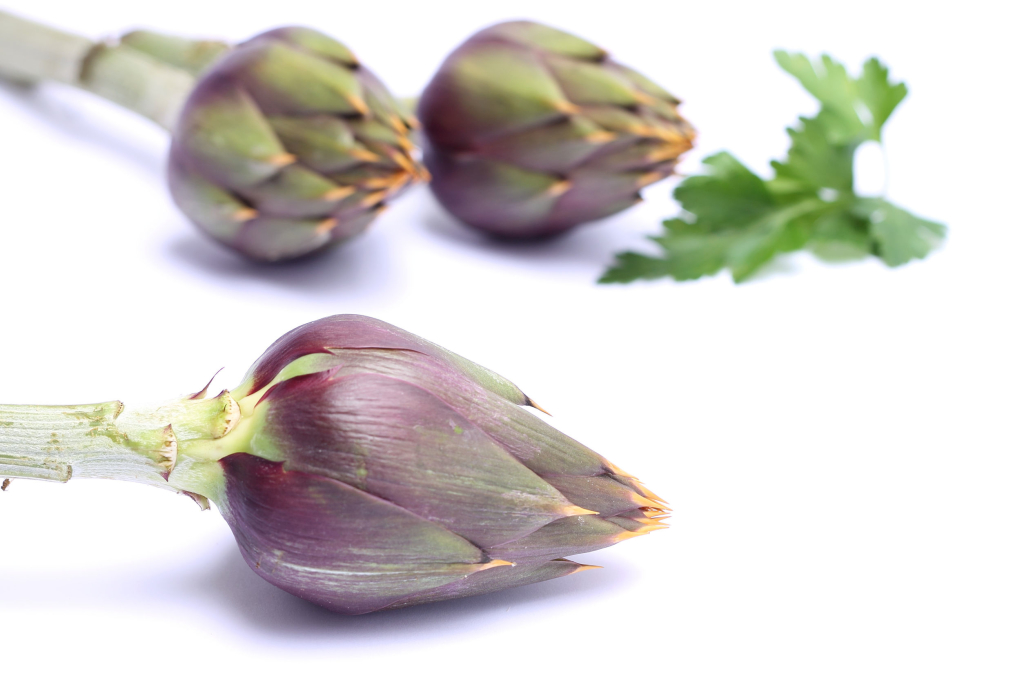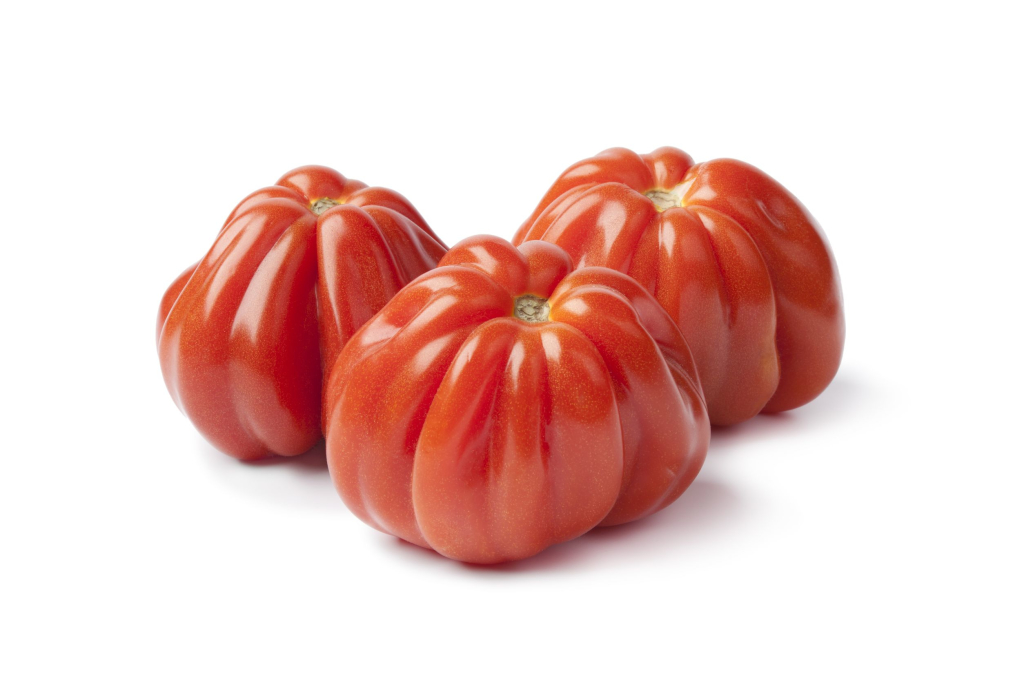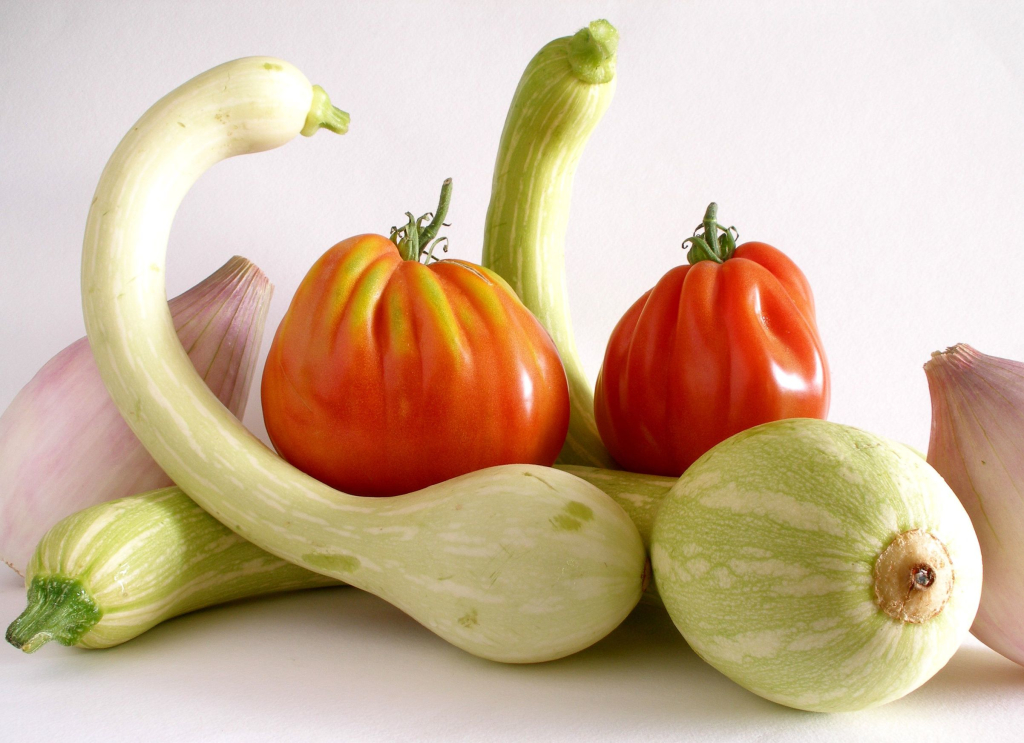Spiny artichoke, beefsteak (in Italian ‘cuore di bue’) tomato, purple asparagus, and ‘trumpet-shaped’ zucchini: this is a poker of vegetable flavours coming from the West Coast of Liguria. The so-called ‘4 of Albenga’ win both Italian and world tables with their really unique flavours. These 4 vegetables follow a rigorous cultivation protocol just for preserving the identity of their aromas, colours, and flavours.
Il carciofo spinato (spiny artichoke)
 With its characteristic cone shape and dark green outer leaves, it is characterized by deep violet hues and yellow plugs. It is little fibrous, with delicate flavour, and it’s eaten either raw or preserved in oil or natural. Its stem, too, is considered a delicacy. Its inner leaves have a sweet flavour and are suitable for freezing, too. It has been in Liguria for thousands of years as a wild plant and was selected by Arab agronomists, who gave it the name of al- kharshûf.
With its characteristic cone shape and dark green outer leaves, it is characterized by deep violet hues and yellow plugs. It is little fibrous, with delicate flavour, and it’s eaten either raw or preserved in oil or natural. Its stem, too, is considered a delicacy. Its inner leaves have a sweet flavour and are suitable for freezing, too. It has been in Liguria for thousands of years as a wild plant and was selected by Arab agronomists, who gave it the name of al- kharshûf.
The tender tomato
 Another delicacy is the so called ‘cuore di bue’ tomato because of its strange irregular shape. Its success is due to the perfect balance of acidity and sweetness, so that it is considered the best tomato which can be used for sauces, both cold ad warm. Its pulp tends to pink and it’s poor in seeds and juice, so it is an ingredient which gives elegance and richness to the common salads or it is used as an appetizer, usually seasoned with oil from the Riviera di Ponente (West Coast) of Liguria. It is also called 'pear of Liguria' and is considered the noble relative of the most common Italian tomatoes.
Another delicacy is the so called ‘cuore di bue’ tomato because of its strange irregular shape. Its success is due to the perfect balance of acidity and sweetness, so that it is considered the best tomato which can be used for sauces, both cold ad warm. Its pulp tends to pink and it’s poor in seeds and juice, so it is an ingredient which gives elegance and richness to the common salads or it is used as an appetizer, usually seasoned with oil from the Riviera di Ponente (West Coast) of Liguria. It is also called 'pear of Liguria' and is considered the noble relative of the most common Italian tomatoes.
The king of Asparagus
 It is a dark violet vegetable which can be really defined unique not only because of its delicate and intense flavour, but also for its botanical characteristics. It has an absolutely pure genome thanks to its 40 chromosomes, twice all the varieties present in the world. This guarantees that it cannot interbreed with other varieties, always preserving the same flavour and the same colour. It is tender but not fragile, with large regular shapes, and is suitable for elegant dinners, where the scenic effect it offers goes along with its flavour. It is fleshy and fragrant and is cooked over a low flame in order to preserve both its beautiful violet colour and flavour. A proverb of Liguria says that violet asparagus has 100 virtues and loses one of them every hour, for highlighting its richness in healthy properties as well as need of eating the freshest possible product. Liguria farmers are able to guarantee this freshness thanks to their long history of trade, which today is supported by the most modern commercial infrastructure.
It is a dark violet vegetable which can be really defined unique not only because of its delicate and intense flavour, but also for its botanical characteristics. It has an absolutely pure genome thanks to its 40 chromosomes, twice all the varieties present in the world. This guarantees that it cannot interbreed with other varieties, always preserving the same flavour and the same colour. It is tender but not fragile, with large regular shapes, and is suitable for elegant dinners, where the scenic effect it offers goes along with its flavour. It is fleshy and fragrant and is cooked over a low flame in order to preserve both its beautiful violet colour and flavour. A proverb of Liguria says that violet asparagus has 100 virtues and loses one of them every hour, for highlighting its richness in healthy properties as well as need of eating the freshest possible product. Liguria farmers are able to guarantee this freshness thanks to their long history of trade, which today is supported by the most modern commercial infrastructure.
A trumpet-shaped Zucchini
 It is a micro-zucchini with a curved shape, an intense aroma and a sweet taste; it is characterized by such a delicate flavour and so tender pulp that it can be eaten raw. It was introduced in Liguria from Americas and it’s marketed with yellow, elegant, and solid flowers, which are eaten as excellent delicacies. It grows as a climbing plant and it is found in this area only. Thanks to the beauty of its shape and flowers, as well as its unique flavour, it has won the most refined tables. The consumption of fried flowers in batter, a typical Italian delicacy, is traditional.
It is a micro-zucchini with a curved shape, an intense aroma and a sweet taste; it is characterized by such a delicate flavour and so tender pulp that it can be eaten raw. It was introduced in Liguria from Americas and it’s marketed with yellow, elegant, and solid flowers, which are eaten as excellent delicacies. It grows as a climbing plant and it is found in this area only. Thanks to the beauty of its shape and flowers, as well as its unique flavour, it has won the most refined tables. The consumption of fried flowers in batter, a typical Italian delicacy, is traditional.
 A concentration of products rich in flavour in a relatively small area has also aroused scientists’ interest. Sandy soil, torn from the sea, constant wind throughout the year, sheltered microclimate, strongly influenced by the sea, have created the ideal conditions for this agriculture of excellence. An ancient agricultural tradition, modern entrepreneurial skills, and a great investment in research have allowed this area to present a local agriculture, but with an international character. In order to enrich the imaginative selection of tasty vegetables, also from western Liguria, oil, the famous basil, fruits, wines, and flowers arrive. A paradise of flavours, overlooking the Mediterranean, rich in DOP, DOC, and IGP certifications.
A concentration of products rich in flavour in a relatively small area has also aroused scientists’ interest. Sandy soil, torn from the sea, constant wind throughout the year, sheltered microclimate, strongly influenced by the sea, have created the ideal conditions for this agriculture of excellence. An ancient agricultural tradition, modern entrepreneurial skills, and a great investment in research have allowed this area to present a local agriculture, but with an international character. In order to enrich the imaginative selection of tasty vegetables, also from western Liguria, oil, the famous basil, fruits, wines, and flowers arrive. A paradise of flavours, overlooking the Mediterranean, rich in DOP, DOC, and IGP certifications.Fresh and ready on the table
This is a non-intensive production, but characterized by very high quality, which follows two directions: fresh and preserved products. In the case of fresh, the packaging is reduced to a minimum and it’s functional to the presentation of special shapes and intense colours of the 4 of Albenga. The products are then marketed poor in labels and packaging, but with a constant reminder to provenance and wholesomeness of the products.
Around this richness of flavour, colour, shape, and health, a market of packaged products, frozen ones, too, was born. Among these products there are preserves, sauces, compotes, where glass dominates, in order to allow violet, dark green, pink colours reminding to the consumers the variety of colours of Liguria.
Vegetables and wine: a perfect wedding
The 4 of Albenga are proposed with the valuable local wines, in order to make the most of their flavour. This happens for instance for Rossese Dolceacqua, one of the oldest wines of Italy, Riviera Ligure di Ponente, and Ormeasco Pornassio.
